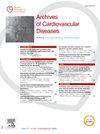Transcatheter edge-to-edge repair of tricuspid valve regurgitation in systemic right ventricle: Echocardiographic outcome
IF 2.2
3区 医学
Q2 CARDIAC & CARDIOVASCULAR SYSTEMS
引用次数: 0
Abstract
Background
Transcatheter edge-to-edge repair (TEER) provides an alternative option for high risk patients with systemic tricuspid regurgitation (STR). Preliminary data of the French study has shown its feasibility and safety, but mid-term echocardiographic outcome is lacking.
Objectives
Echocardiographic outcome of TEER in systemic tricuspid regurgitation.
Methods
TEER French cohort is a multicentre, longitudinal, descriptive, prospective study of patients undergoing TEER for severe STR. 20 patients with severe or greater STR undergoing percutaneous repair with the MitraClip system were enrolled in the study between May 2019 and November 2024. A transthoracic echocardiography was performed at baseline, six months, one year and two years after the procedure. TR was assessed using standard 2-dimensional color Doppler methods and graded TR using the 5-class grading scheme: mild, moderate, severe, massive, and torrential. The number of clips and their localization was analyzed.
Results
A reduction of at least 1 grade in TR was achieved in all subjects. TR grade remained moderate or less in 83% of patients at 2-years follow-up. TR reduction was sustained at 2-years follow-up for all patients. Among 14 patients, 5 patients had one-clip implantation, and 9 patients had two or more clips implantation. TR grade seemed to be lower in the group of patient with 2 or more clips strategy: TR was mild in 67% of patients in 2 or more clips group and moderate in 100% of patients in 1-clip group.
Conclusion
TEER of systemic tricuspid regurgitation is found to be safe and effective, with sustained effects at 2 years in patients. Patients with two or more clips implantation seem to have a better outcome in the regurgitation grade, but additional data and a bigger cohort are needed to predict the outcome and define the optimal technical strategy.
经导管边缘对边缘修复系统性右心室三尖瓣反流:超声心动图结果
背景:经导管边缘到边缘修复(TEER)为系统性三尖瓣反流(STR)的高风险患者提供了另一种选择。法国研究的初步数据显示其可行性和安全性,但缺乏中期超声心动图结果。目的探讨TEER在系统性三尖瓣反流中的超声心动图结果。steer法国队列是一项多中心、纵向、描述性、前瞻性研究,研究对象是接受TEER治疗严重STR的患者。2019年5月至2024年11月,20名接受MitraClip系统经皮修复的严重或更严重STR患者入组。在基线、术后6个月、1年和2年进行经胸超声心动图检查。采用标准的二维彩色多普勒方法评估TR,并采用轻度、中度、重度、大面积、暴雨5级分级方案对TR进行分级。分析了片段的数量及其定位。结果所有受试者的TR均降低1级以上。在2年随访中,83%的患者TR等级保持中等或更低。所有患者的TR在2年随访中持续降低。14例患者中5例为单夹植入,9例为双夹及以上植入。2个或更多夹子组患者的TR等级似乎较低:2个或更多夹子组中67%的患者TR为轻度,1个夹子组中100%的患者TR为中度。结论teer治疗全身性三尖瓣反流安全有效,持续疗效可达2年。植入两个或更多夹子的患者似乎在反流级有更好的结果,但需要更多的数据和更大的队列来预测结果和确定最佳的技术策略。
本文章由计算机程序翻译,如有差异,请以英文原文为准。
求助全文
约1分钟内获得全文
求助全文
来源期刊

Archives of Cardiovascular Diseases
医学-心血管系统
CiteScore
4.40
自引率
6.70%
发文量
87
审稿时长
34 days
期刊介绍:
The Journal publishes original peer-reviewed clinical and research articles, epidemiological studies, new methodological clinical approaches, review articles and editorials. Topics covered include coronary artery and valve diseases, interventional and pediatric cardiology, cardiovascular surgery, cardiomyopathy and heart failure, arrhythmias and stimulation, cardiovascular imaging, vascular medicine and hypertension, epidemiology and risk factors, and large multicenter studies. Archives of Cardiovascular Diseases also publishes abstracts of papers presented at the annual sessions of the Journées Européennes de la Société Française de Cardiologie and the guidelines edited by the French Society of Cardiology.
 求助内容:
求助内容: 应助结果提醒方式:
应助结果提醒方式:


